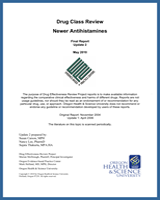From: Evidence Tables

Drug Class Review: Newer Antihistamines: Final Report Update 2 [Internet].
Carson S, Lee N, Thakurta S.
Portland (OR): Oregon Health & Science University; 2010 May.
Copyright © 2010 by Oregon Health & Science University,
Portland, Oregon 97239. All rights reserved.
NCBI Bookshelf. A service of the National Library of Medicine, National Institutes of Health.